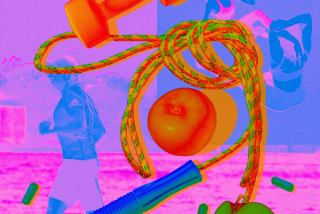The Inside Skinny on How to Eat and Run
- Share via
I could not believe my ears the other day when a family friend dropped by the house, sat on the couch in my office and suggested that she might never travel again.
“You can’t mean that,” I said. “You love to travel. You’re as close to being a complete travel nut as anyone we know.”
“If I’m some kinda travel nut, you can bet your life it’s round. Look at me. One month in Europe and I’ve turned into a blivit.” (A blivit is 10 pounds of anything crammed into a five-pound bag.)
Always on a Diet
“It’s so unfair,” she said, “that at the time in your life when you can finally afford to travel, when you can go to the places where they have all those fabulous foods, you’re always on a diet.”
“Who told you to diet?” I asked. “Some overweight doctor? An aerobics teacher who looks like she’s made out of pipe cleaners? Or have you been watching TV soap operas or the commercials with those actresses and models with the cavernous cheeks who all look alike. You don’t want to look like them.”
“Oh, don’t I?” She took a tissue from her purse.
“Who are the world’s great painters of beauty? Botticelli, Rubens, Rembrandt, Vermeer, that’s who. Any one of them would have picked you in a minute as a model over the Jane Fondas and the Chers. . . .”
I thought I was making progress but for some reason she was looking even sadder.
“You’re the picture of health. Not a wrinkle in your face,” I said.
“That’s because I’ve filled them all up with fat,” she answered. “And my clothes don’t fit anymore.”
“Disuse makes fabric stiffen.”
“I’m talking about the clothes I wore on the trip.”
“Oh well, hand-laundering in hotel rooms shrinks clothes.”
“You’re a good friend,” she said, “but I really don’t think you know what you’re talking about.”
“Oh?” I answered. “Oh? Well, you know how much I travel and it just so happens I’ve worn the same belt size for 15 years.”
“But you’re wearing it about a foot lower now than you used to.”
“Well, take my word for it, you look great.”
Ready to Cry
She started to cloud up.
“I don’t mean that kind of great, I mean good . Don’t worry about dieting. You don’t have any problem but maybe a little jet sag.”
“That’s jet lag . Jet lag . There is no such thing as jet sag .”
“Oh, yeah,” I said. “I meant water retention.”
“Get off it,” she said.
“What about air retention?” I asked.
“Where’s Joyce?” she asked, and walked out into the back yard where my wife was doing a little gardening.
In the days that followed I looked into the matter. I learned that our family friend was not unusual in her misery. Weight gain has been worrying a lot of travelers throughout the world. Some almost to the point of hysteria. Is it time to be hysterical?
Probably not. And I believe I have something to support that opinion.
It is necessary to point out that what follows is not purely my creation. Some has been gleaned from experts as august as Julia Child and Mike Royko.
The words that follow are not those of some collection of doctors and nutritionists (probably skinny) hanging around the lunchroom at the Mayo Clinic, Johns Hopkins or Boston General.
This is the wisdom of real people from the eating and traveling public whom I’ve met at Weight Watchers, where I am a life member, or with whom I’ve shared membership in any of a dozen other diet groups.
An Organized List
This is not merely a rehash of known diet studies. I have taken the liberty of organizing information seldom considered and forming 10 conclusions that should be of special interest to anyone who has ever worried about gaining weight while traveling.
1. Any food that is the national dish of the country visited is not fattening and should be eaten out of consideration for your host or hostess. Asking for seconds in such circumstances should be thought of as a positive international political gesture.
2. Food served at birthday, anniversary and bon voyage parties, including wedding cakes with a written message in frosting on top, aren’t fattening because they are eaten not for nourishment but to honor another person. Thirty-six percent of those familiar with this “fact,” however, are of the opinion that such eating causes the person being honored to put on weight.
3. Hors d’oeuvres contain no calories. Though the term is French for “outside of work,” it is defined as an appetizer. As something can’t build appetite and satisfy it at the same time, hors d’oeuvres must be calorie-free. Reason alone tells us this.
4. Food eaten while standing and talking contains no calories. The reason for this is unclear, but it has been known, if not well-publicized, for centuries.
5. When traveling with one’s children the eating of foods to illustrate the potability of certain dishes, known as “demonstration food,” is non-caloric. That’s as in: “Try it, dear. See, mother is eating some. It’s good. See? Isn’t that delicious? Watch mother take another bite. Umm . . . and another.”
6. When eaten in Switzerland, the Netherlands, Germany or the United Kingdom, foods containing chocolate are not fattening. They may even be considered to have negative calories when incorporated into a national food and eaten standing up.
For instance, Black Forest cake, when eaten in front of an open refrigerator, is covered under three or four other nonfattening rules and is therefore counted negatively, meaning (theoretically) that the eater should lose weight while eating it.
7. The “old food” or “hard food” rule. When one discovers old food in a jacket pocket or among carry-on luggage, the food may be consumed with no thought of weight gain if it has hardened. The calories are assumed to have either leaked out or to have bled off into the atmosphere.
One of the experts opined, from personal experience, that it is wise to restrict consumption to one’s own old food, and to be able to identify it before consuming it.
8. The definition of a calorie is the amount of heat required to raise 1 gram of water through 1 degree centigrade, so the “refrigerator rule” may be considered. Standing before an open refrigerator, which tends to lower body heat, would use up more calories than the individual might consume.
The caloric intake might be virtually eliminated if the eater also holds an unthawed ice tray under each arm while snacking.
9. To “even up” leftover cake, pie, pudding or casserole dishes for aesthetic reasons is not fattening. Trifle is excluded because it never gets completely evened.
10. On a recent trip to Poland our group had lunch at a hotel where we were served two varieties of Polish dumplings. Several members of the party who had eaten inordinate amounts voiced concern.
Our official Polish state guide, when asked if the dumplings were fattening, answered, “Certainly not. You are not going to digest them so they cannot possibly make you fat. In fact, your bodies will expend so much energy just trying to process those dumplings that you will probably lose weight.”
He added that he felt the same theory applied to certain other ethnic, dumpling-type foods made from unsalted crackers, adding: “There may be a temporary weight gain, such as if one had eaten a small cannonball, but it soon passes.”
Please bear in mind that although expressed by worthy and sincere people, the above are opinions . You may accept them or take them with a grain of salt, but do not, under any conditions, stop traveling.
P.S. A grain of salt contains no calories.
More to Read
Sign up for The Wild
We’ll help you find the best places to hike, bike and run, as well as the perfect silent spots for meditation and yoga.
You may occasionally receive promotional content from the Los Angeles Times.






